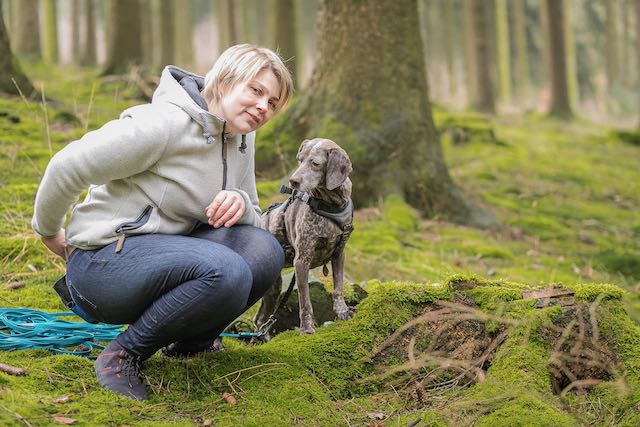In many of my blog articles I have already looked at the topic of pain from different angles. It is a broad subject area and very complex. On the other hand, it is also quite simple: pain affects life. Also the lives of our dogs. So even a good dog training with your four-legged friend in pain is not possible. Since for me body and mind are closely connected, I am happy about this guest article by dog trainer Anne Bucher. Not only does she explain how good behavior training with your dog builds up and why you should have a lot of patience in the process, she also addresses what happens in training when your dog is in pain. Have fun and insights with this great article!
Good dog training requires many small steps – and patience!
No matter if you have a fearful, impulsive, jittery or hard to motivate dog: You can achieve lasting changes through a combination of good training and genuine well-being.
The training provides the behavioral change. It is systematic, small-step and structured. Thereby it contains several components, which are influenced by the problem, the living environment and of course also by the dog, but in general always contain the following:
Management
To ensure that the behavior occurs as infrequently as possible and is not further practiced and reinforced, determine when, how, and where the behavior occurs and how it can be prevented. The better you can prevent it for a time, the faster your training will progress.
The goal is not to avoid the problem permanently, but to get a foot in the door first. To build up the necessary training repertoire and to regenerate in the meantime.
The more often the dog exhibits the behavior, even at a basic level, the harder it will be to get rid of it. A good trainer will therefore not ask you to demonstrate the behavior once if you have not filmed it anyway. No one assumes you can completely prevent it overnight, so it’s all the more important to refrain from “intentionally” triggering it. This goes double and triple if it’s a behavior that doesn’t feel good to the dog, you, or anyone in the environment, or is even dangerous.
Learning a new strategy.
In the meantime, your dog and you can learn new training tools, handling and handling. You can learn how to react in a sudden slip and make the best of it afterwards.
From this, a new strategy emerges that should feel good to you and your dog and meet your needs. The better the strategy, the more likely your hud will execute it afterwards without your intervention and that should be the medium to long term goal. You don’t want to be in a figure-eight position forever when you walk the dog!
Generalize and establish the new strategy
Once the two of you are in tune with what you’re doing, it’s time to bring the new strategy back to life. To train piece by piece on different triggers, places and in different arousal situations. If you accidentally overstep the mark or get into difficult situations, it’s no big deal. You freshen up your training again, do a few more days of management and on you go!
Sounds lengthy? It usually is not. You should see significant changes and progress after just a short time. Of course, sometimes there are setbacks and learning doesn’t happen in a straight line. But usually after a few weeks noticeable improvements are noticeable. If this is not the case, it is important to question your training and in any case to examine the second aspect very closely:
Without your dog’s well-being, your training will not bear fruit in the long run!
Training as described above will boost your confidence and well-being. It is fun and welds together. However, it’s a battle against windmills when other things are overlooked that permanently disrupt well-being.
In my experience, one of the most common reasons for this is musculoskeletal pain. Whether it’s tucking the tail, pulling on the line, jumping violently into the line, or stopping suddenly at the fence, they all have one thing in common: they cause misalignment that leads to tension, sprains, and other pain.
It is not uncommon for the pain to even be there first and then the behavior begins to tip. But no matter which came first: If both are there, it only helps to work on both.
Pain activates fear!
When pain occurs, the neural network of fear also becomes active. Fear is a strong emotion that is necessary for survival and activates corresponding behavior patterns. Often we associate fear only with flight, with a trembling hiding being. But fear has many faces and so does pain. They all have one thing in common: the dog’s brain wants to avoid or alleviate the occurrence at all costs. If it doesn’t succeed, it looks for distractions and things that will make it happier again.
You give your dog a signal, like sit, he scurries around, offers umpteen other behaviors, maybe barks or backs off. Your dog is in conflict. His brain tells him to sit down, at the same time it warns him of the pain of doing it. Often we think the dog is jittery, petulant or stubborn. However, he only avoids the pain.
Your dog is a real fidget and does not come at home to rest. It may be that lying down or lying down is uncomfortable. Pinch it several times in such a situation, the dog tries to avoid it. The reactions that trigger pain are not always logical and clear to us. From our perspective, it does not make sense that the hunting motivated dog nevertheless goes over hill and dale to pursue the game when it is in pain. The common fallacy: No pain!
The preferred behaviors do the dog good at that moment. Hormones and neurotransmitters are released that not only make you happy, but also ensure that the pain is not perceived at that moment. The deeper the corresponding behavior is anchored in the brain, the more the dog has been selected for it, the more likely it is to occur under stress and pain.
If the brain is looking for new, nice stimulation, things that are self-rewarding become more important. Rewards from outside, on the other hand, are mitigated. So self-rewarding behaviors are becoming more important and more. This leaves the door open to the development of unpleasant behavioral problems, up to and including disorders such as excessive chasing or barking.
Pain is a facilitating factor of problem behavior
Anxiety and pain always trigger stress. If your dog is frequently exposed to stress, his learning ability will change. The lightning-fast emotional structures in the brain condense and impulsive and reactive responses become faster and perhaps more violent.
A simple “sit,” on the other hand, is becoming increasingly difficult. This is because the area of the brain responsible for signal and impulse control is weakened during this time. The stressed dog brain is in “autopilot”, everything that does not bring an immediate improvement of the situation (from the dog’s perspective) is first disconnected.
In the more sluggish types of dogs, instead of the quicker reactions, lethargy and withdrawal tend to develop. They are increasingly difficult to motivate. Those who frequently have to endure pain, stress and anxiety become increasingly thin-skinned and are less able to learn anything that is not directly and immediately related to pain, anxiety and stress. In addition, there are incorrect linkages. A classic: Your dog sees the other dog, he jumps into the leash and it hurts. Logical who is to blame, right? Always the other. His brain was right again – other dogs are stupid!
This is not only true for other dogs. Your dog is frightened, e.g. because of a loud noise, he flinches and something hurts? Thus, a full-blown noise anxiety may well develop.
The best at the end
Tackle both ends at the same time and you’ll almost certainly see really good changes very soon!
So you, you and your dog, are not at the mercy of the situation. You can tackle it and many trainers like to work hand in hand with therapists and veterinarians. And even if you can’t change what you’ve experienced, you can build a lot of well-being and good, new strategies for the future.
About Anne Bucher

Anne Bucher is a dog trainer and founder of Anne Bucher – Anders mit Hund.
Their mission is to ensure that everyone has access to guidance and knowledge to spend a needs-based life with their dog. To make this happen, Anne accompanies dog owners on and offline, gives lectures in German-speaking countries and trains dog trainers who share the same values.
https://www.facebook.com/AnneBucherAndersmitHund
Dieser Beitrag ist auch verfügbar auf:
Français (French)
Deutsch (German)
Español (Spanish)
















